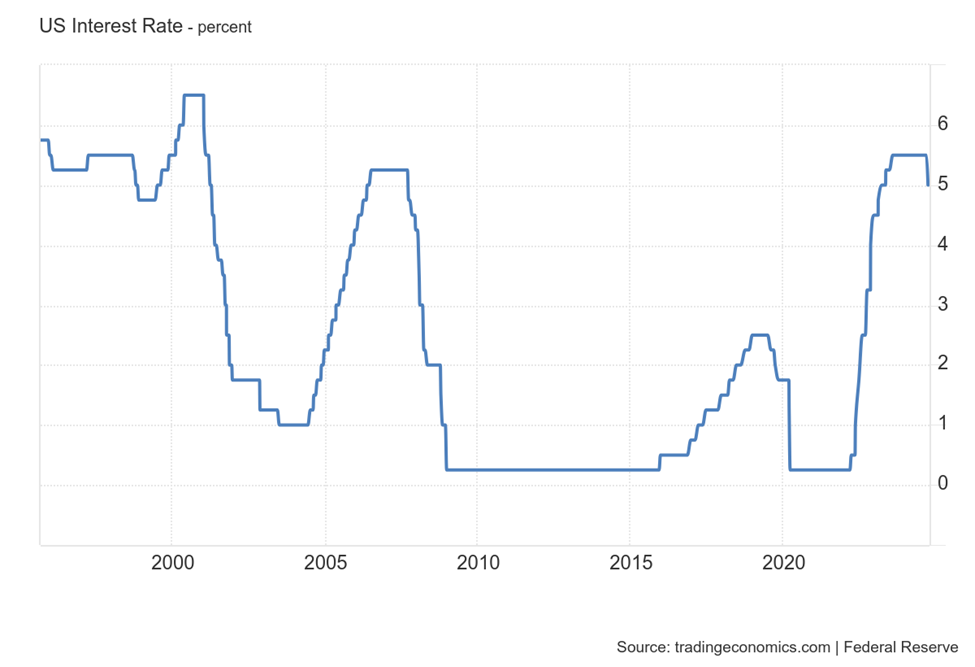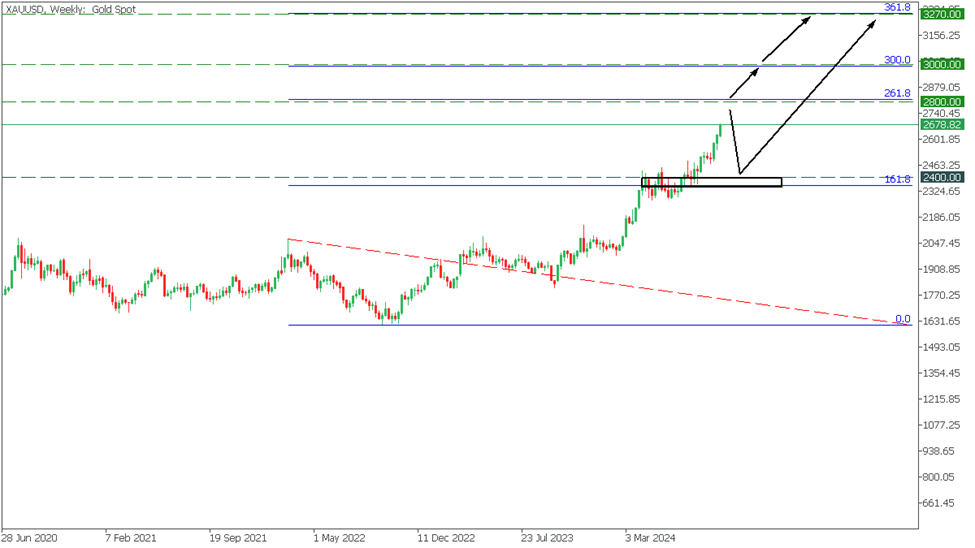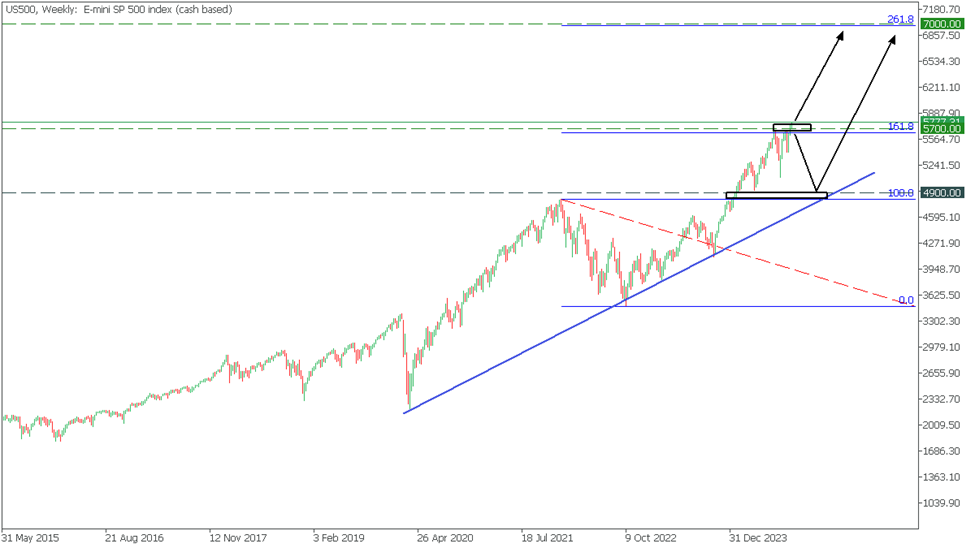The Federal Reserve’s current resolution to slash rates of interest by an surprising 0.5% has despatched shockwaves by way of world monetary markets. This daring transfer, bigger than the modest cuts many analysts anticipated, has heightened volatility throughout shares, currencies, and commodities. Preliminary reactions noticed a pointy uptick in inventory costs, adopted by an equally swift decline, reflecting investor uncertainty in regards to the financial outlook. Such a major price minimize raises vital questions in regards to the catalysts behind the choice, its historic parallels, and its potential influence on foreign money pairs, gold, and inventory indices. This text delves into the causes of the Fed’s substantial price discount, compares it to earlier financial actions, explores future coverage instructions, and analyzes the repercussions on key monetary markets.
Breakdown of the 0.5% price minimize
On September 18, 2024, the Federal Reserve took a daring step by slicing rates of interest by 0.5%, a call that shocked markets and analysts alike. This transfer lowered the federal funds price from 5.25% – 5.50% to 4.75% – 5.00%, marking essentially the most important discount in over 4 years and setting a brand new course for US financial coverage after a 12 months of holding charges regular. The Fed cited rising issues over slower financial development, inflationary pressures nearing management, and slight labor market softening as the important thing causes behind this aggressive motion.
Catalysts behind the minimize
The backdrop to this price minimize consists of each home and world components. US financial development has been step by step weakening, with actual GDP development projections lowered to 2.7% for the 12 months, up from the sooner estimate of two.4%. Moreover, regardless of inflation trending towards the Fed’s 2% goal, the core inflation price stays elevated, with the Fed revising its projection for 2024 to three.4%, in comparison with 3.6% in June. Labor market situations are additionally shifting, with unemployment anticipated to extend to 4.1% in 2024, barely above the earlier projections of 4.0%.
Globally, components similar to ongoing commerce tensions with China, diminished European demand, and protracted provide chain disruptions have added additional stress on the US financial system. Domestically, the housing market stays strained, with residence affordability challenges as a consequence of excessive costs. Whereas mortgage charges are anticipated to say no following the speed minimize, affordability stays a priority.
Quick market reactions
The market’s response was unstable and combined. Initially, US shares surged, with indices just like the and NASDAQ hitting all-time highs as traders anticipated cheaper borrowing prices and potential assist for company earnings. Nonetheless, the rally was short-lived, as fears of deeper financial issues, notably the potential for an financial slowdown, shortly surfaced. By the top of the day, important indices had declined, reflecting the uncertainty surrounding the broader financial outlook.
In bond markets, yields on US Treasuries fell sharply as traders sought the security of presidency debt. The yield on the 10-year Treasury, for instance, dropped to 4.1%. The US greenback additionally weakened towards main currencies, together with the euro and the yen, as decrease rates of interest made dollar-denominated belongings much less enticing to overseas traders. This decline within the greenback has broad implications for world commerce, probably making US exports extra aggressive however elevating the price of imports.
The Federal Reserve’s resolution to chop rates of interest by 0.5% in September 2024 echoes important financial coverage actions from the previous, notably these in 2001 and 2007. By inspecting these historic cases, we will glean insights into potential outcomes and market reactions related to such aggressive price reductions.
Echoes from the previous
2001 price minimize
In response to the bursting of the dot-com bubble and the following financial slowdown, the Federal Reserve launched into a rate-cutting cycle beginning in January 2001. The Fed diminished the federal funds price from 6.5% to 1.75% by the top of the 12 months, totaling a 4.75% lower. This aggressive stance aimed to stimulate funding and client spending amidst declining company earnings and rising unemployment, which peaked at 5.8% by the top of 2001.
Regardless of these efforts, the S&P 500 skilled a downturn, declining roughly 10% within the three months following the preliminary price minimize. The aggressive cuts have been unable to totally counteract the unfavorable sentiment attributable to the tech sector collapse, resulting in extended market stagnation and contributing to the early 2000s recession.

2007 price minimize
Going through the rising subprime mortgage disaster, the Fed initiated a rate-cutting cycle in September 2007, lowering charges by 0.5% from 5.25% to 4.75%. Over the following 12 months, the Fed continued to decrease charges, culminating in a near-zero price surroundings by the top of 2008.
Market Impression: Whereas the preliminary price cuts supplied momentary reduction, the depth of the monetary disaster that unfolded in 2008 overwhelmed these measures. The S&P 500 plummeted by 57% from its peak in October 2007 to its trough in March 2009.
Comparative evaluation with 2024
Not like the pre-recession durations of 2001 and 2007, the US financial system 2024 shouldn’t be formally in a recession. As of September 2024, GDP development stands at 2.7%, unemployment is barely elevated at 4.1%, and inflation has been introduced nearer to the Fed’s goal, with core inflation projected at 3.4%.
These indicators recommend a extra nuanced financial surroundings than the clear downturns previous the 2001 and 2007 price cuts.
Submit-2008 regulatory reforms have fortified the banking sector, lowering systemic dangers. Banks now preserve increased capital reserves, and stress-testing procedures are extra rigorous, probably mitigating the fallout from aggressive price cuts.
The Fed possesses a broader arsenal of financial coverage instruments, together with quantitative easing and ahead steering, which have been much less developed throughout the earlier rate-cut cycles. These instruments can present extra focused assist to particular sectors with out broadly impacting all the financial system.
The 2024 price minimize happens in a extremely interconnected world financial system, the place coordinated coverage responses from different main central banks can affect outcomes. In 2001 and 2007, world coverage coordination was much less strong, exacerbating financial downturns.
If the Fed can leverage its enhanced coverage toolkit and the financial system stays resilient, the 2024 price minimize could keep away from the extreme market downturns seen in 2001 and 2007. Nonetheless, persistent world financial uncertainties, similar to commerce tensions and geopolitical dangers, may nonetheless pose important challenges.
Will the Fed proceed to chop charges?
The Fed’s price minimize marks the start of an extended easing cycle. As inflation has slowed to 2.9%, the Fed’s focus has shifted from combating inflation to addressing slowing financial development and softening the labor market. The massive query stays: will the Fed proceed to chop charges, and in that case, how aggressively?
A number of key components will drive the Fed’s choices within the coming months:
● Inflation: With inflation nearing the Fed’s 2% goal, the speedy stress to proceed price hikes has eased. Nonetheless, core inflation, which excludes unstable vitality and meals costs, nonetheless stays barely increased at 2.7%. Continued moderation in inflation may give the Fed room to decrease charges additional, notably if different financial indicators weaken.
● Labor Market: The unemployment price has risen to 4.2%, up from 3.6% earlier in 2023, as job openings have declined and wage development has slowed. If the labor market continues to melt, the Fed could really feel compelled to chop charges additional to stimulate employment. The speed is anticipated to rise to 4.5% by the top of 2025.
● International financial slowdown: Weaker development in main economies like China and Europe, mixed with persistent geopolitical tensions, can be exerting stress on the US financial system. Regardless of China’s excessive stimulus measures, European trade continues to shrink, with common unemployment charges rising, particularly in Germany. If world demand shrinks, the Fed might have to chop charges to assist home development.
The Fed’s “dot plot” projections from the September assembly point out that extra price cuts are doubtless earlier than the top of 2024. The present projection factors to a further 50 foundation factors of cuts, which might carry the federal funds price right down to a spread of **4.25% – 4.5%**. This aligns with market expectations, as traders are already pricing in not less than two extra price cuts earlier than the 12 months ends.
Nonetheless, a sudden resurgence of inflation, notably pushed by provide chain points or rising vitality prices, may pressure the Fed to rethink its easing technique, probably resulting in price hikes in 2025.
Given the present parameters and dynamics, the Federal Reserve will step by step scale back rates of interest, reaching the three.00% vary by the top of 2025. The forecast assumes that price cuts will start in 2024 to deal with slowing financial development, assist stability the US financial system, curb inflation, and assist the labor market.
Market ripples: DXY, gold, and S&P 500
The sharp price minimize has raised a number of questions and issues amongst market individuals, as many banks and consultants anticipated solely a 0.25% discount. This important financial coverage shift has prompted a reevaluation of asset valuations throughout currencies, commodities, and equities.
US Greenback
Following the speed minimize, the US greenback is beneath elevated stress and is anticipated to weaken additional. Goldman Sachs forecasts a 3-5% decline within the (DXY) over the following few months. This anticipated decline is basically as a result of narrowing yield differential between the US and different main economies.
Traditionally, price cuts have nearly all the time led to a weaker greenback, and an identical pattern is anticipated this time, particularly given the potential of one and even two extra price cuts on the horizon.
Gold
Gold rose considerably after the US Federal Reserve price minimize, rising to an unprecedented $2,627 per ounce. Goldman Sachs forecasts that gold costs will common round $2,800 by the fourth quarter of 2024 and will attain $3,000 by mid-2025. This optimistic outlook is additional supported by escalating geopolitical tensions, with a number of world conflicts intensifying. Nonetheless, some banks and consultants anticipate an much more important rise by the top of 2024. UBS predicts that gold may hit $3,000 an oz. by early 2025, particularly if the Federal Reserve continues its aggressive rate-cutting cycle. For instance, FBS consultants level out that elevated central financial institution purchases and a world shift away from the US greenback are the primary components supporting this upward trajectory. As well as, gold’s conventional position as an inflation hedge is being bolstered by ongoing financial uncertainty. Industrial demand additional helps gold costs, particularly within the electronics and synthetic intelligence sectors.
Within the Weekly timeframe, is approaching the 261.8 Fibonacci degree, indicating a long-term bullish pattern. Given the extraordinarily bullish market sentiment, we will anticipate an increase, though a correction could happen earlier than that.
● If Gold overcomes the resistance at 2800, it’ll rise to 3000 after which to 3270;
● A rebound from the resistance will drop XAUUSD first to the assist space of 2400, after which the worth will go up;
S&P 500
The speedy response to the US Federal Reserve’s price minimize was optimistic: main US inventory indices, such because the S&P 500, rose markedly. Nonetheless, long-term forecasts recommend a extra subdued outlook. JP Morgan expects that the S&P 500 may rise by 6.6% over the following 12 months, barely beneath the historic common. Decrease borrowing prices are anticipated to partially offset the advantages of slower financial development.
Sectors that might profit most from the unfastened financial coverage embody expertise and client staples, which have traditionally thrived in a low-interest-rate surroundings. Expertise shares, particularly these concerned in synthetic intelligence and semiconductor manufacturing, have risen considerably as cheaper financing encourages growth and innovation. In distinction, cyclical sectors similar to industrial and monetary firms may face headwinds if financial development stays weak.
Within the Every day timeframe, the US500, in a long-term bullish pattern, made an all-time excessive once more on the 161.8 Fibonacci degree. Based mostly on the present dynamics, we will anticipate a minor correction earlier than a protracted rise.
● If the bulls push the worth above the 5700 resistance, the goal will likely be 7000, similar to 261.8 Fibonacci;
● A rebound from the resistance will drop the US500 to the pattern line, after which additional upside development may be anticipated;
Conclusion
The Federal Reserve’s official price minimize has begun, signaling the potential for additional reductions forward. The decline within the US greenback favored currencies such because the euro and the yen, whereas gold costs soared to document highs amid decrease alternative prices and inflation issues. US inventory indexes have proven preliminary volatility, and additional efficiency depends upon the Fed’s means to stability price cuts and financial development. Because the market adjusts to the brand new financial coverage surroundings, merchants and traders have a singular alternative to evaluate dangers and make knowledgeable trades, given {that a} clear trajectory has already been established.